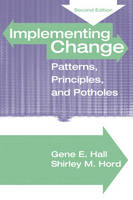
Implementing Change
Pearson (Verlag)
978-0-205-46721-1 (ISBN)
- Titel erscheint in neuer Auflage
- Artikel merken
Each chapter concludes with "Summary."
Dedication.
Table of Contents.
Preface.
Part I. The Context for Implementing Change.
1. Implementing Change Patterns, Themes and Principles.
Focus Questions.
Principles of Change.
Change Principle 1: Change is a process, not an event.
Change Principle 2: There are significant differences in what is entailed in development and implementation of an innovation.
Change Principle 3: An organization does not change until the individuals within it change.
Change Principle 4: Innovations come in different sizes.
Change Principle 5: Interventions are the actions and events that key to success of the change process.
Change Principle 6: There will be no change in outcomes until new practices are implemented.
Change Principle 7: Administrator leadership is essential to long-term change success.
Change Principle 8: Mandates can work.
Change Principle 9: The school is the primary unit of change.
Change Principle 10: Facilitating change is a team effort.
Change Principle 11: Appropriate interventions reduce resistance to change.
Change Principle 12: The Context of the school influences the process of change.
2. Developing professional learning communities and understanding organizational culture.
Focus Questions.
Context? Climate? Culture?
Organizational Context.
Five Disciplines.
Seventeen Factors.
The PLC Context and Culture.
Dimensions of a Professional Learning Community.
Shared Values and Vision.
Collective Learning and Application.
Supportive and Shared Leadership.
Supportive Conditions.
Shared Personal Practice.
Who is the Professional Learning Community.
Benefits of a Professional Learning Community.
Schools.
Leadership Teams.
University.
Leadership in a Professional Learning Community.
Collegial Learning.
Sharing Responsibilities.
Using Conversations.
Types of Leadership.
Other Ideas to be Considered.
Strategies for Facilitating a Collaborative Culture.
Our Closing Pitch.
Part II. Different Perspectives for Understanding the Big Picture of Change.
3. Systems Thinking: Interconnections of Parts that Make a Whole.
Focus Questions.
Familiar Names in Systems Thinking.
Going Deeper to Examine a Systems View.
Components of the Educational System.
Components of Systems in Change.
Characteristics of Systemic Policy.
Elements of Systemic Reform.
Working Systemically in Schools.
Components.
Levels.
Competencies for Working Systemically.
The Cube.
Competencies from Other Writers.
Effects of Working Systemically.
Outcomes for Educators.
Results for Students.
Facilitators and Barriers to Working Systemically.
Facilitators of the change.
Barriers to the Change Process.
Limitations of Working Systemically.
4. Diffusion: Communication and Change Agents.
Focus Questions.
Communication of Innovations.
Sources, Targets and Media.
Sources of Communication.
Targets of Communication.
Purpose of Communication.
Media in Communication.
Coding Communication Actions in General.
Lines of Communication.
Interpersonal Communication.
Networks are a Means of Communication.
Implications of Communication Tools for Facilitating Change.
Characteristics of Adopters.
Five Adopter Categories.
Innovators.
Early Adopters.
Early Majority.
Late Majority.
Laggards.
Passing the Word.
Opinion Leaders.
Communicating Across Adopter Categories.
Perceived Attributes of the Innovation.
Relative Advantage.
Compatibility.
Complexity.
Trialabilty.
Observability.
The Role of Change Agents.
5. Organization Development: Problem Solving and Process Consultants.
Focus Question.
What is OD?
OD Definitions Across the Decades.
Training and Planning.
Changing OD Definitions.
OD Intervention Tools and Techniques.
Survey Feedback.
Exercises.
Finding and Sharing OD Exercises.
Group/Team and Individual Process Skills.
Group Decision Making and Problem Solving.
Decision Making.
Problem Solving.
Meeting Skills.
Individual Process Skills.
Individual Team Member Process Skills.
Using OD to Change Whole Organizations.
Assessing and Developing Climate/Culture.
Organizational Climate Defined.
Climate versus Culture.
Assessing Organization Culture.
Strategic: Planning.
OD Process Consultants.
OD Consultants at Work.
Planned Change Steps.
OD Consultant Issues.
6. Clarifying the Change: Innovation Configurations.
Focus Questions.
Innovation Adaptation.
Innovation Configurations as a Concept.
Mapping Innovation Configurations.
Innovation Configuration Maps.
Innovation Configurations: Applications and Implications.
Using IC Maps in Research, Evaluation, and Implementation Assessments.
The Fidelity Enigma.
7. Understanding Feelings and Perceptions about Change: Stages of Concern.
Focus Questions.
The Personal Side of Change.
Stages of Concern about an Innovation.
Fuller’s Unrelated, Self, Task, and Impact Concerns.
Connecting Concerns to Teacher Education.
Concerns and the Change Process.
Identifying the Stages of Concern.
Why are They Called “Stages” of Concern?
Can There be Concerns at More than One Stage?
Are There Typical Concerns Profiles?
Techniques for Assessing Stages of Concern.
The One-Legged Interview.
The Open-Ended Statement.
The Stages of Concern Questionnaire.
Characteristic Stages of Concern Profiles.
Implications of Resistance in Stages of Concern Profiles.
8. Exploring the Use of Innovations.
Focus Questions.
The Levels of Use Concept.
Nonusers.
Users.
Assessing an Individual’s Level of Use.
The LoU Branching Interview.
The LoU Focused Interview.
Applying Levels of Use.
Facilitation of Change.
Motivation for Movement in LoU.
Evaluation of Change.
Sidelights about LoU.
Part IV. The Imperative for Leadership in Change.
9. Describing What Change Facilitators Do.
Focus Questions.
Intervention Definition.
Intervention Delivery.
Six Functions of Interventions.
Function I: Developing, Articulating, and Communicating a Shared Vision of the Intended Change.
Function II: Planning and Providing Resources.
Function III: Investing n Professional Learning.
Function IV: Checking on Progress.
Function V: Providing Continuous Assistance.
Function VI: Creating a Context Supportive of Change.
Additional Kinds of Interventions.
Communicating Externally.
Disseminating Information.
Sizes of Interventions.
Policies.
Game Plan Components.
Strategies.
Tactics.
Incidents.
The Anatomy of Interventions.
Source.
Target.
Function.
10. Defining Change Facilitator Style.
Focus Questions.
The History of Research on Leaders and Leadership.
The Legacy of Research on Leadership.
Studies of Leaders during the Change Process.
The Concept of Change Facilitator Style.
Three Change Facilitator Styles.
Discussion and Implications of Change Facilitator Style.
A Continuum of Change Facilitator Styles.
Additional Research and Support for Change Facilitator Styles.
Research Relating Change Facilitator Style to Implementation Success.
Metaphors for Change Facilitator Styles.
Underlying Dimensions of Change Facilitator Style.
Changing Change Facilitator Style.
Change Facilitator Style as a Significant Factor in Change.
Change Facilitator Style as a Heuristic.
Working with Different Change Facilitator Styles.
The Relationship of Change Facilitator Style to Other Factors.
Changes in Change Facilitator Style.
The Relationship of Change Facilitator Style to Organizational Variables.
11. Constructing Understanding of Change: Intervention Mushrooms.
Focus Questions.
Introducing Mushrooms: A Unique Form of Intervention.
Two Ways of Knowing: Objectivist and Interpretivist.
Intervention Mushrooms are Constructed.
Four Aspects of Intervention Mushrooms.
The Life Cycle of Intervention Mushrooms.
The Birth of a Mushroom.
The Growth of a Mushroom.
The Maturity of a Mushroom.
Keys to the Construction of Intervention Mushrooms.
Levels of Use as a Rubric for Developing Understanding of Mushrooms.
Stages of Concern as Source of Mushrooms.
Change Facilitator Style and Mushrooms.
Dealing wit Growing Mushrooms.
Evergreen Mushrooms.
Part V. Combing Views and Tools.
12. Implementing Change: Applications, Implications and Reflections.
Focus Questions.
Different Units of Intervention.
The System as the Unit of Change.
An Organization as the Unit of Change.
Teams or Divisions as the Unit of Change.
The Individual as the Unit of Change.
Bridging the Gap: Evaluating Implementation and the Connections to Outcomes.
Using Stages of Concern to Introduce a New Product to a National Sales Force.
Planning for the New Product Launch.
The Three Day National Sales/Training Meeting.
The Rest of Story.
Connecting Extent of Implementation with Outcomes.
A School District Superintendent wants to Know.
Measuring Implementation (LoU).
Measuring Implementation (IC).
Answering the Bottom-line Question.
Reflections about Organization Culture: Its Construction and PLC.
Relationships between Organization Culture and Leader Succession.
Indicators of Organization Culture.
Organization Culture is a Social Construction.
The CF Style of Leaders Make a Difference in Organization Culture.
Implications of CF Style and Organization Culture for Leader Succession.
A Systemic View of PLC.
The Learning of Professionals.
Participants in the Community.
Post Modernism: Another Change Perspective.
The Foundations of Postmodernism and Critical Theory.
Early Views.
The Importance of Critique.
The Use of Language.
Postmodernism, Critical Theory and the Change Process.
Change Leaders are “Functionalist.”
Critical Theorists as Change Agents.
Critique as a “Tool” for the Functionalist.
Final Reflections about Implementing Change.
Ethical Issues in Facilitating Change.
Understanding the Constructs.
What about the Ethics of Change Agentry?
Responsible Use.
External Versus Internal Impetus for Change.
Support at All Levels of the Organization.
The Caveat.
A Final Phrase.
Reference List.
Appendix 1. Stages of Concern Questionnaire.
Appendix 2. SoCQ Quick Scoring Devise.
Appendix 3. Levels of Use of the Innovation.
Appendix 4. Six Dimensions of Change Facilitator Style.
Index.
| Erscheint lt. Verlag | 6.9.2005 |
|---|---|
| Sprache | englisch |
| Maße | 152 x 229 mm |
| Gewicht | 431 g |
| Themenwelt | Sozialwissenschaften ► Pädagogik |
| ISBN-10 | 0-205-46721-0 / 0205467210 |
| ISBN-13 | 978-0-205-46721-1 / 9780205467211 |
| Zustand | Neuware |
| Haben Sie eine Frage zum Produkt? |
aus dem Bereich



